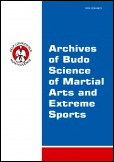2014, Volume 10, Issue 1
Internal proportions of body composition in women practising modern pentathlon
Marina Jagiełło1, Władysław Jagiełło1
1Gdańsk University of Physical Education and Sport, Gdańsk, Poland
Full text
Abstract
Background and Study Aim: Athletes belonging to the world elite in a particular sport, provide the most accurate information on intrinsic properties of their body composition. Knowledge of internal proportions of the body plays an important role in the assessment of athletes’ body composition. The purpose of the study was the properties of body composition in athletes of the Polish national team in modern pentathlon in comparison to members of the same population not professionally engaged in sport.
Material and Methods: Eleven female athletes of the Polish National Team in modern pentathlon were tested. The competitors were 18-35 years old (23.37 ± 5.2), their body weight was from 54-65 kg (59.4 ± 3.6) and the body height 160-180 cm (170.2 ± 5.6). The athletes’ training experience was 6-20 years (12.4 ± 4.4). One hundred and fifty female students of Warsaw University of Technology (Poland) constituted the reference group. Internal proportions of body composition were assessed by means of Perkal’s natural indicators.
Results: An analysis of internal proportions of factors of athletes’ body composition revealed significant differences in individual groups of features. The total volume of the athletes’ bodies results from low intensity of stoutness features and even one of length and of adiposity. The proportions of features within the analysed factors showed a distinct advantage of the length of the upper extremity over the sitting body height (the length factor) and the domination of musculature of the forearm (the stoutness factor).
Conclusions: The specific profile of body composition in athletes practising modern pentathlon is most likely due to the long-term effects of training as well as the system of selection of persons with specific somatic predisposition developed in the course of many years of training practice.
Key words: combat sport, fencing, perkal's method, perkal’s natural indicators





